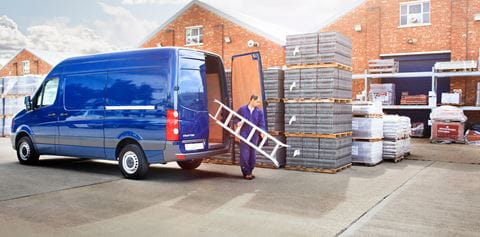
How to load a light commercial vehicle safely
Securely securing cargo is half the battle to road safety.
We’ll give you five tips to allow the driver and his/her cargo arrive safely at their destination.

There is a risk of injury due to the load
Over time, there have been many advances in safety technology in the Light Commercial Vehicle (LCV) industry to minimise the number of accidents on the road. However, despite all the advances, there is a fundamental aspect that has often been ignored: the risk of serious injuries caused by the load.
An apparently innocuous unsecured item on the cargo bed of a truck or van – such as a laptop or a smartphone – can cause damage when a vehicle stops suddenly and unexpectedly and can actually become a lethal weapon in the event of an impact. Ironically, even a first-aid kit can do more harm than good in an accident situation if not securely closed.
Under the law, the driver is responsible for safely transporting any item in or on the vehicle and also for ensuring that the vehicle does not exceed its permissible gross weight.
To ensure you take on this responsibility as a driver and maintain the highest safety standards, here are some useful tips and recommended practices for properly loading and unloading your vehicle. **This will help keep not only you, but also your vehicle and your cargo safe at all times.
- Manual transport
- Respect a maximum weight limit of 25 kg for manual transport carried out by one person.
- Do not lift any significant weight above waist height, for example to place on a roof rack.
- Get some help when loading/unloading any items that exceed this weight limit or use a cargo trolley.
- Gross vehicle weight rating
The gross vehicle weight rating indicates the maximum operating weight of any vehicle, including the driver, passengers, fuel and cargo. The value is stated in the vehicle registration documents, in the manufacturer's manual and on the manufacturer's weight plate.
- Make sure that the vehicle does not exceed this limit when loaded and that the load distribution respects the maximum admissible weights per axle.
- Vehicle access
- Before loading an item, first check that there is enough space inside the vehicle to accommodate it safely.
- Make sure that the open door (s) is (are) secure and cannot close on you when loading.
- Before entering the vehicle, ensure that there is a secure base in place to minimise the risk of slipping or tripping.
- Make sure the vehicle's loading area is well lit enough for you to load/unload safely, so that any hazards are clearly visible.
- Stowing the load
- Before loading items into the vehicle, make sure that they are in transport conditions, properly packaged and stowed or, in the event of bulk transport, that they are housed in suitable containers.
- Ensure that the weight of items is safely distributed across the cargo area to keep the vehicle safely balanced and within axle weight limits. Place the heaviest objects closer to the ground to keep the centre of gravity as low as possible.
- To minimise damage to the vehicle, both to the occupants and the load when the vehicle is in motion and when at a standstill, make sure that all loaded objects are correctly stowed in order to prevent them from moving during the trip: do not place unsecured objects in the vehicle's cargo box or directly behind the occupants; use appropriate restraint straps and nets, secured to the anchorage points available on the vehicle, whether using fastening eyes or strips. And use storage tools and equipment in rack systems, if they are available.
- Take load placement and load weight into account when driving. Needless to say, a heavily loaded vehicle is slower to accelerate and requires a longer braking distance than a vehicle carrying a lighter load.
- Check the load regularly throughout the day: double-check the systems used to stow objects shortly after starting your journey or after heavy braking. Reposition items as the load increases or decreases to keep the vehicle evenly balanced.
- Roof and ladder
- If your vehicle is equipped with roof rails or a roof rack, take extra care to carefully load and secure items. To avoid the risk of falling, do not climb onto the roof to secure objects.
- Do not overload the roof bars. Check the manufacturer's manual for the maximum weight limit, but remember that this includes the weight of the crossbar itself and that the weight must also be evenly distributed. Ideally, the weight on the roof should be as little as possible for reasons of safety, protection and convenience; so it is preferable to load items inside the vehicle when possible.
- Before continuing your journey, ensure that all items are securely attached to the roof (e.g. using ladder clips or straps). Regularly check the tethers (and especially if the vehicle has been left overnight) to make sure they have not come loose or been tampered with. Furthermore, the wear and tear of the retention systems themselves must also be checked regularly and replaced if necessary.







.webp?rev=116e33c4df5f409b9d0b0a6dbb2810ac&mw=480&io=transform%3Afill%2Cwidth%3A480)